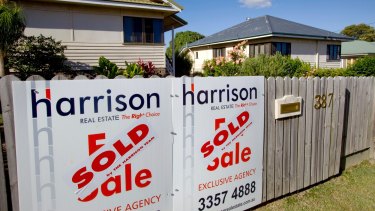Price crash fears subside as mortgage holidays end for tens of thousands of home owners
Advertisement
Tens of thousands of home owners are repaying their loans again after lengthy mortgage holidays and experts expect Sydney will now avoid the double-digit property price crashes that were predicted at the height of the pandemic.
Seven per cent of mortgages, worth $133 billion, were not being repaid in September, new Australian Prudential Regulation Authority data shows. This is down from 11 per cent in May at the height of the crisis. September was the third consecutive month where more people ended their repayment holidays than entered them.

House prices have held up better than expected and previous forecasts of crashes are being revised.Credit:Glenn Hunt
At the height of uncertainty in May about the effects of coronavirus on unemployment, the nation's biggest lender, the Commonwealth Bank of Australia, tipped 11 per cent property price falls by March 2023 as a "base case" scenario and up to 32 per cent in a prolonged downturn. National Australia Bank expected an 11 per cent drop in 2021 and, in a severe scenario, falls of about 30 per cent over the next two years.
However, with home loan deferrals showing signs of recovery these forecasts are shifting. CBA home loan data shows the number of customers on a mortgage holiday had fallen from 154,000 at the peak of the coronavirus crisis to 93,000 in September. Around 17,000 customers (nearly half of whom are from Victoria) have extended their payment pause.
AdvertisementThe trend is similar at other major banks. ANZ disclosed last week that about 80 per cent of its 55,000 customers whose mortgage holiday had ended have now returned to full payments. Another 40,000 were still in their first deferral period. ANZ forecasts residential property prices to fall 2.2 per cent in the 2020 calendar year, drop 4.8 per cent next year and then increase 2 per cent in 2022.
CBA senior economist Gareth Aird has forecast Sydney house prices to fall 0.9 per cent over the year to December 2020. The steepest fall is expected to be in the 12 months to June 2021, with a 4.9 per cent drop before rising again.
Mr Aird suspected that outlook may even be too gloomy for some areas, particularly with unemployment improving in most states, sustained low interest rates and promises of further government support.
"Everyone had the same view in April that there would be quick and sizeable falls. We thought this would be about 10 per cent over six months and at the time this looked about right," Mr Aird said.
"House prices are just not falling at that rate. There are still headwinds, with loan deferral drop offs and migration. But by mid-August we were thinking we'd no longer see these [double digit] falls."
He said substantial government stimulus had helped offset the worst of the job losses, with Victoria lagging behind due to restrictions to stop the second wave spread of the virus, alongside sustained record low interest rates which economists are widely predicting will be cut again on Tuesday.
LoadingCommittee for Economic Development of Australia senior economist Jarrod Ball said there were some "crash scenarios" predicted earlier in the year tied to high unemployment rates and underestimating the federal government support. Instead, housing market performance has differed drastically by state and territory.
"Fiscal support has been more extensive than people imagined, but there's a significant divergence in price trends across the states [and territories]," Mr Ball said.
In Victoria, 310,128 businesses are currently receiving JobKeeper on behalf of staff compared to 272,136 in August. In NSW 352,389 workplaces are receiving the wage subsidy up from 339,673 in August.
The latest Domain House Price Report, released last week, showed Sydney house prices already rebounded in the September quarter, with the median rising 1.2 per cent to $1.15 million. Prices continued to fall for apartments, but at a slower rate, with the median dropping 0.2 per cent to $732,423.
"What we're going to see in these cities over the next year or so will likely be house prices moving in step with the labour market and depending on the success of dealing with COVID," Mr Ball said.
The property market has also managed to avoid a spike in distressed payments, PRD Real Estate chief economist Diaswati Mardiasmo said attributing this to the stimulus and support available, including welfare payments, wage subsidies, superannuation withdrawals, mortgage freezes and, in some areas, council rates holidays.
"Overall we saw the property market hold steady – as a whole country – during the worst of COVID-19," Dr Mardiasmo said. "So now that we are on the road of recovery, and that there is pent up demand ready to enter the market, we should finish strong in 2020."
"There is a potential of a slight dip in activity once all government incentives are off in mid-2021, however this is to be expected as the economy is returning to its normal pace," she said.
SaveLog in, register or subscribe to save articles for later.License this articleJennifer Duke
Jennifer Duke is an economics correspondent for The Sydney Morning Herald and The Age, based at Parliament House in Canberra.
Loading